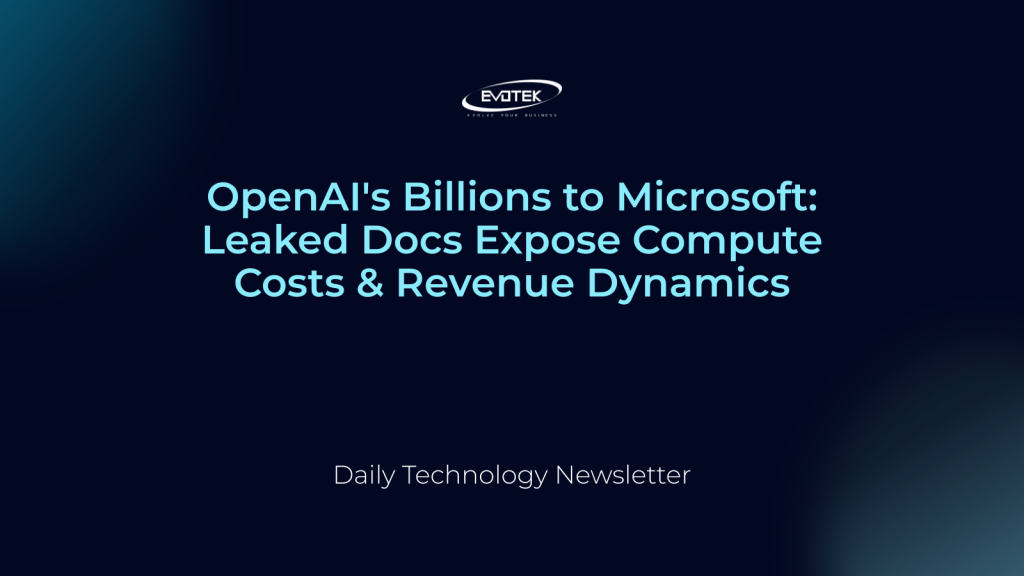The financial intricacies of OpenAI, the generative artificial intelligence powerhouse, are under heightened scrutiny as leaked documents provide a rare glimpse into its revenue and colossal compute expenses. These revelations, brought to light by tech blogger Ed Zitron, underscore the staggering financial flows within the AI industry’s most prominent partnership.
Microsoft’s Share from OpenAI’s Success
According to the documents viewed by Zitron, Microsoft received substantial revenue share payments from OpenAI. In 2024, these payments totaled an impressive $493.8 million. This figure surged dramatically in the first three quarters of 2025, reaching an estimated $865.8 million.
Industry whispers suggest OpenAI remits 20% of its revenue to Microsoft. This arrangement is reportedly a cornerstone of Microsoft’s strategic investment in the AI startup, which has exceeded $13 billion. While neither OpenAI nor Microsoft has publicly confirmed this specific percentage, it serves as a crucial data point for understanding the scale of their financial interdependencies.
A Complex Financial Web: Net vs. Gross Revenue Share
The relationship isn’t a simple one-way street. A source familiar with the matter revealed that Microsoft also shares approximately 20% of its revenue from Bing and the Azure OpenAI Service back with OpenAI. Bing heavily leverages OpenAI’s AI capabilities, and the Azure OpenAI Service offers businesses and developers cloud access to OpenAI’s sophisticated models.
Crucially, the leaked payment figures represent Microsoft’s net revenue share. This means the numbers exclude any royalties or payments Microsoft remits to OpenAI from its Bing and Azure OpenAI Service revenues. These reciprocal payments are reportedly deducted internally by Microsoft before arriving at the disclosed net figures.
Decoding OpenAI’s Revenue and Soaring Expenses
Though Microsoft does not itemize its Bing and Azure OpenAI earnings, the leaked figures offer a window into OpenAI’s burgeoning financial landscape. Assuming the widely reported 20% revenue-share model holds true, we can infer significant top-line figures for OpenAI:
- OpenAI’s revenue likely stood at least at $2.5 billion in 2024.
- For the first three quarters of 2025, implied revenue jumps to at least $4.33 billion.
These projections align somewhat with previous reports, such as The Information estimating OpenAI’s 2024 revenue at roughly $4 billion and its first-half 2025 revenue at $4.3 billion. CEO Sam Altman has also recently indicated that OpenAI’s revenue is “well more” than reported figures of $13 billion annually, projecting an annualized run rate exceeding $20 billion by year-end and potentially hitting $100 billion by 2027.
However, the documents also spotlight OpenAI’s immense spending on compute resources, particularly for ‘inference’ – the process of running trained AI models to generate responses. Zitron’s analysis suggests:
- OpenAI’s inference spend was approximately $3.8 billion in 2024.
- This expenditure dramatically increased to roughly $8.65 billion in the first nine months of 2025.
Historically, OpenAI has primarily relied on Microsoft Azure for its compute needs, though it has diversified by striking deals with CoreWeave, Oracle, and more recently, AWS and Google Cloud.
While previous reports pegged OpenAI’s total compute spend at about $5.6 billion for 2024 and its “cost of revenue” at $2.5 billion for the first half of 2025, a crucial distinction exists between training and inference costs. Training spend, the resources required to initially train a model, is largely non-cash, often covered by credits from Microsoft’s investment. Inference spend, however, is predominantly cash-based.
The AI Bubble Question: Costs vs. Revenue
The significant implication of these figures is stark: OpenAI may be spending more on inference costs than it is generating in revenue. This imbalance could intensify the ongoing “AI bubble” discourse permeating discussions from Silicon Valley to New York City.
If even the industry leader, OpenAI, is operating in the red when running its models, it raises critical questions about the sustainability and jaw-dropping valuations of other AI ventures. The data serves as a potent reminder that while AI promises transformative capabilities, the underlying infrastructure and operational costs are astronomical.
OpenAI declined to comment on these findings, and Microsoft did not respond to requests for comment.

 日本語
日本語 한국어
한국어 Tiếng Việt
Tiếng Việt 简体中文
简体中文